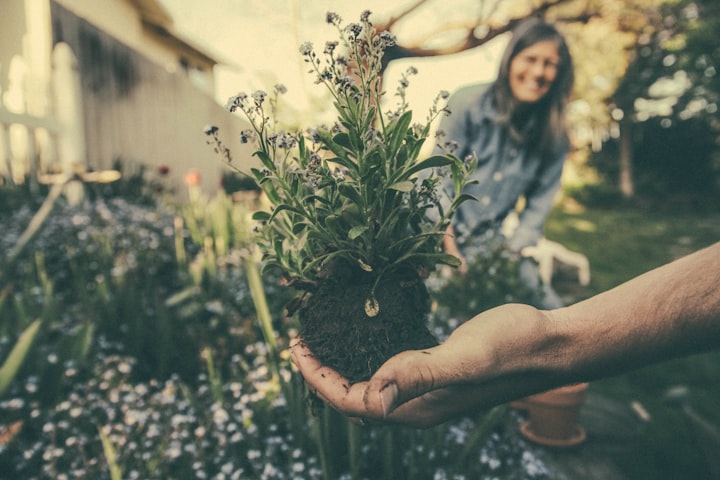
Gardening is a rewarding and fulfilling hobby that allows you to connect with nature, grow your own food, and create a beautiful outdoor space. If you're a beginner, getting started might seem overwhelming, but with some basic knowledge and a little patience, you can develop a green thumb and enjoy the benefits of gardening. In this guide, we'll walk you through the essential steps to help you embark on your gardening journey.
Planning and Preparation:
Before you start digging, take some time to plan your garden. Consider the available space, sunlight exposure, and the type of plants you want to grow. Start with a small area or container garden if you have limited space. Observe the amount of sunlight your garden receives throughout the day, as different plants have varying light requirements.
Soil Preparation:
Healthy soil is the foundation of a successful garden. Test your soil's pH level to determine its acidity or alkalinity. Most plants thrive in slightly acidic to neutral soil. Amend your soil with organic matter such as compost or well-rotted manure to improve its structure and fertility. This will provide essential nutrients to your plants and improve water drainage.
Selecting Plants:
Choose plants that are well-suited to your climate, soil type, and available sunlight. Consider whether you want to grow vegetables, flowers, or a mix of both. Research the specific requirements of the plants you're interested in, including watering needs, spacing, and any special care instructions. As a beginner, you may wish to opt for varieties labeled as "beginner-friendly" or "easy to grow."
Starting from Seeds or Seedlings:
Decide whether you want to start your plants from seeds or purchase young seedlings from a nursery. Growing from seeds can be more affordable, but it requires additional time and care. Seedlings, on the other hand, offer a head start and are generally more reliable. Follow the instructions on seed packets or seek advice from local experts to ensure proper germination and growth.
Planting and Transplanting:
Follow the recommended planting guidelines for each plant. Prepare the soil by removing weeds and loosening it with a garden fork or tiller. Dig a hole that is deep and wide enough to accommodate the plant's roots. Gently remove the plant from its container or seed tray, being careful not to damage the roots, and place it in the hole. Fill the hole with soil, firm it gently, and water thoroughly.
Watering:
Proper watering is crucial for the health of your plants. The frequency and amount of water depend on the type of plant, weather conditions, and soil moisture. Generally, it's better to water deeply and less frequently than to water lightly every day. Water in the morning or evening to minimize evaporation. Avoid wetting the leaves to prevent fungal diseases, and consider using mulch to retain moisture.
Fertilizing:
Plants need essential nutrients to grow and thrive. Organic fertilizers, such as compost or well-rotted manure, are ideal for providing a slow release of nutrients. Alternatively, you can use commercially available balanced fertilizers. Follow the instructions on the package for the correct application rates. Be careful not to over-fertilize, as it can damage your plants.
Pest and Weed Control:
Keep an eye out for pests and weeds, as they can damage your plants and compete for resources. Identify common garden pests and learn about organic pest control methods. Regularly inspect your plants for signs of infestation and take appropriate measures to address the issue. Mulching, hand weeding, and using organic herbicides can help control weeds.
Pruning and Maintenance:
Pruning promotes healthy growth and enhances the appearance of plants. Remove dead or diseased branches, and trim back excessive growth to maintain the shape and size of your plants. Different plants have different pruning requirements, so research the specific needs of each plant in your garden. Regularly check for signs of diseases or pests and take immediate action if any issues arise.
Mulching:
Mulching is the process of adding a layer of organic material, such as wood chips, straw, or compost, to the soil surface around your plants. Mulch helps to retain moisture, suppress weed growth, and regulate soil temperature. Apply a layer of mulch around your plants, leaving space around the stems to prevent rotting. Replenish the mulch as needed throughout the growing season.
Monitoring and Observation:
Gardening requires attentive observation. Regularly check your plants for any signs of stress, disease, or nutrient deficiencies. Look for changes in leaf color, wilting, or abnormal growth patterns. Monitor weather conditions and adjust your watering and care practices accordingly. The more you observe and learn from your garden, the better you'll understand the needs of your plants.
Harvesting and Enjoying:
One of the most rewarding aspects of gardening is reaping the fruits of your labor. Harvest vegetables, fruits, and herbs when they are ripe and ready. Cut flowers for bouquets or simply enjoy their beauty in your garden. Share your harvest with friends and family or explore the art of preserving and canning to enjoy your garden's bounty throughout the year.
Continuous Learning:
Gardening is an ongoing learning experience. Take advantage of resources such as books, online forums, and local gardening clubs to expand your knowledge and skills. Learn about companion planting, crop rotation, and organic gardening practices. Experiment with new plants and techniques to keep your gardening journey exciting and evolving.
Seasonal Care:
Different seasons require different care for your garden. In spring, focus on soil preparation, planting, and early pest control. Summer requires regular watering, mulching, and ongoing maintenance. Fall is the time for harvesting, cleaning up garden beds, and preparing for winter. In winter, protect your plants from frost and cold temperatures.
Enjoy the Process:
Lastly, remember that gardening is a process that requires patience and perseverance. Embrace the joy of watching your plants grow, adapt to challenges, and flourish. Don't be discouraged by setbacks or failures—learn from them and keep going. Gardening is not just about the end result, but also the journey and the connection it provides with nature.
In conclusion, gardening for beginners can be an incredibly rewarding experience. By following these essential steps, planning and preparing, selecting appropriate plants, providing proper care, and continuously learning, you can create a thriving garden that brings beauty, nourishment, and joy to your life. Enjoy the process, embrace nature, and watch as your garden grows and flourishes under your care. Happy gardening!






Comments
There are no comments for this story
Be the first to respond and start the conversation.